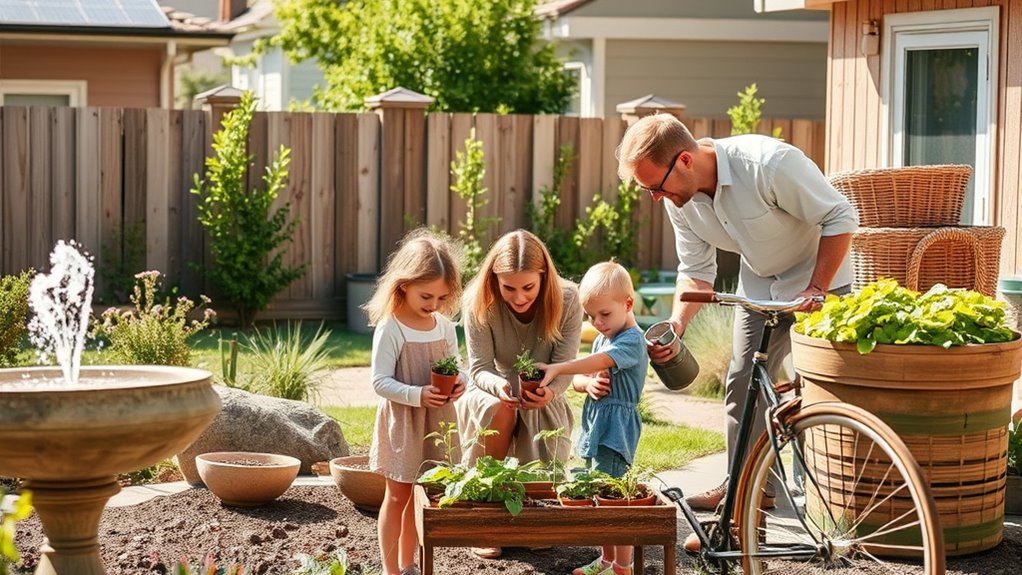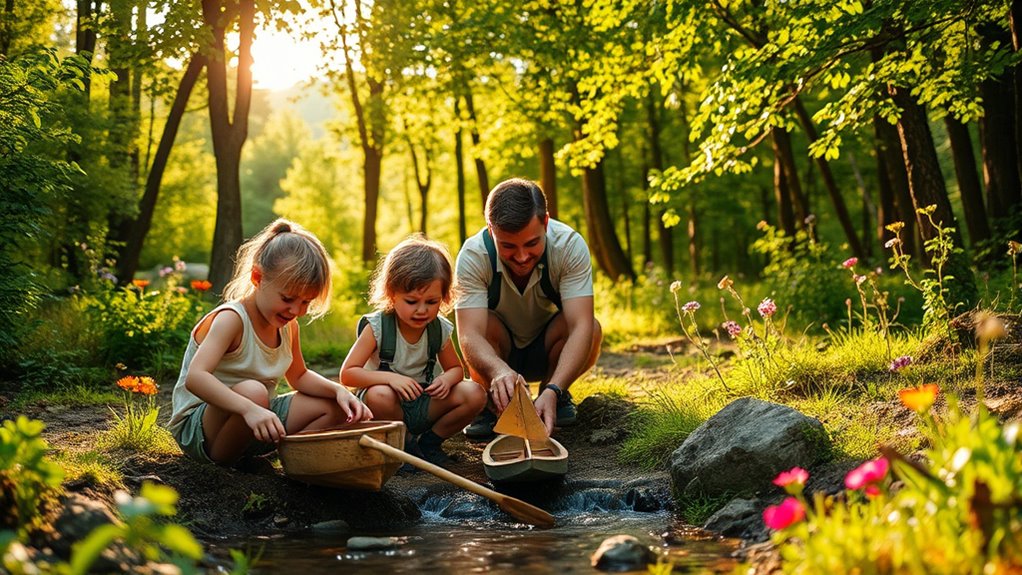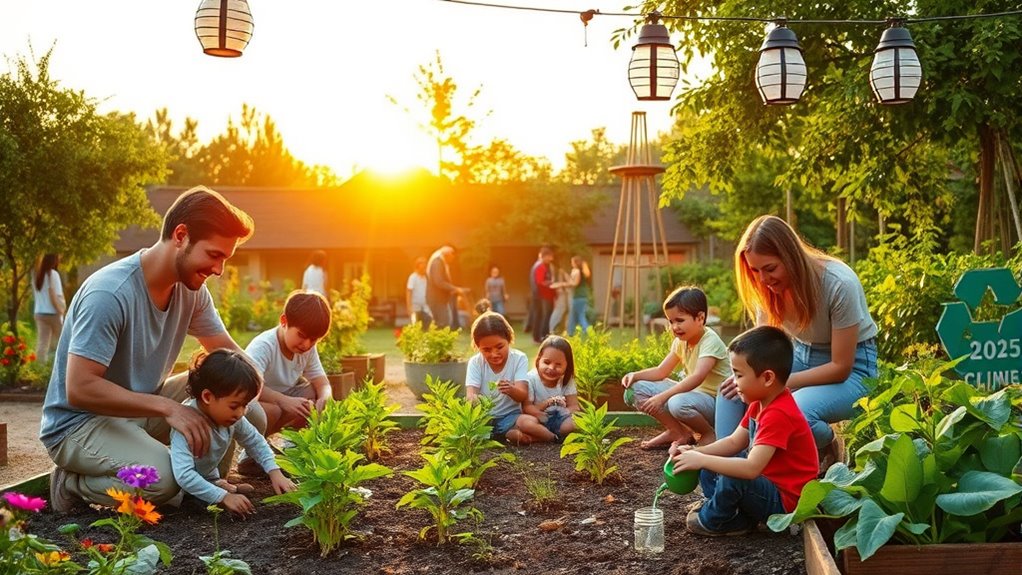To raise eco-conscious kids in 2025, start by incorporating simple, sustainable habits into daily routines, like using reusable items and practicing energy conservation. Teach children about climate change and environmental impact using age-appropriate conversations, and choose eco-friendly products, such as organic clothes and foods. Engage them in outdoor activities and nature exploration, fostering a love for the environment. Building a community of like-minded families can reinforce these efforts—continue exploring to discover more ways to nurture eco-consciousness in your children.
Key Takeaways
- Incorporate eco-friendly habits into daily routines and model sustainable behaviors for children.
- Educate kids about climate change, environmental impact, and sustainability through age-appropriate discussions and activities.
- Choose sustainable products made from organic or recycled materials to teach mindful consumption.
- Engage children in outdoor activities, nature exploration, and community projects to foster environmental connection.
- Build a community of eco-minded families to support long-term environmental awareness and collective sustainability efforts.
Incorporating Eco-Friendly Practices Into Daily Routines

Integrating eco-friendly practices into your daily routines doesn’t have to be complicated. Start with simple swaps, like choosing eco-friendly fashion options made from sustainable materials. This not only reduces your environmental impact but also sets an example for your family.
Simple swaps like eco-friendly fashion can reduce impact and inspire your family’s green habits.
Implement waste reduction techniques such as using reusable bags, containers, and water bottles to cut down on single-use plastics. You can also optimize laundry habits by washing clothes in cold water and air-drying when possible. Additionally, practicing mindfulness in your daily choices can help you become more aware of the environmental impact of your actions. Being mindful of your carbon footprint encourages more thoughtful consumption and lifestyle decisions.
Incorporating these small changes makes a big difference over time. By consciously selecting eco-friendly fashion and practicing waste reduction techniques daily, you create a sustainable lifestyle that benefits both the environment and your family’s future. Research shows that environmental awareness can significantly influence family habits and promote greener behavior.
Additionally, understanding the importance of raw food in promoting a healthier, more sustainable diet can inspire your family to incorporate more plant-based and minimally processed foods into your meals. Embracing raw food diets can also help reduce energy consumption associated with cooking processes and preserve more nutrients in food, fostering a greener mindset for everyone.
Teaching Kids About Climate and Environmental Impact

Teaching kids about climate and environmental impact builds on the eco-friendly habits you’re already fostering at home. You can help them understand their role in reducing their carbon footprint and promoting renewable energy.
Start by explaining how everyday choices matter:
- Choosing bike rides or walking instead of car trips to cut emissions.
- Turning off lights and electronics when not in use to save energy.
- Supporting renewable energy sources like solar or wind power when possible.
- Eating more plant-based meals to lessen environmental impact.
- Incorporating top mattress toppers can improve sleep quality, which is vital for children’s health and development. Additionally, understanding the importance of sustainable materials in products can further instill eco-conscious values.
- Teaching children about climate change helps them grasp the urgency of environmental conservation. Encourage curiosity by discussing how these actions help protect the planet. Use simple language to connect their behaviors with larger climate issues.
- Explaining the benefits of renewable energy sources can motivate them to support eco-friendly initiatives and understand how energy choices impact the environment. Engaging children with environmental education activities can deepen their understanding and foster lifelong eco-conscious habits.
The goal is to empower them to see their influence and take active steps toward sustainability.
Choosing Sustainable Products and Materials for Children

Choosing sustainable products and materials for children allows you to reduce environmental impact while providing safe, healthy options. Prioritize eco-friendly fashion by selecting clothing made from organic cotton, hemp, or recycled fabrics, which minimizes chemical use and waste. Numerous apps available for tracking keto diet When it comes to food, opt for organic choices that avoid pesticides and synthetic fertilizers, supporting both your child’s health and the planet. Look for certifications like GOTS or OEKO-TEX to ensure eco-conscious production standards. Avoid plastics and synthetic materials whenever possible, selecting natural, biodegradable alternatives. By making mindful decisions, you promote sustainability in your child’s daily life, teaching them the importance of caring for the environment from an early age. Using safe and fresh ingredients can also help ensure your child’s well-being while reducing reliance on spoilage-prone items. Small, consistent choices can lead to a lasting positive impact.
Engaging Children in Nature and Outdoor Activities

Spending time outdoors not only benefits your child’s physical health but also nurtures their curiosity and connection to the environment. To make outdoor activities engaging, try these ideas:
- Organize nature scavenger hunts, encouraging kids to find leaves, rocks, or flowers, fostering observation skills. Incorporating environmental awareness into these activities can deepen their understanding of nature’s importance.
- Create outdoor art projects using natural materials like sticks, stones, and leaves, stimulating creativity.
- Set up simple obstacle courses in the yard to promote active play and coordination.
- Plan regular family picnics in parks or green spaces to enjoy fresh air and nature’s beauty. Remote hackathons demonstrate how digital platforms can connect people across distances—similar approaches can help families share outdoor experiences regardless of their schedules or locations.
Additionally, choosing dog names that reflect natural or adventurous qualities can inspire children to appreciate their surroundings more deeply. These activities help children develop eco-consciousness naturally, while making outdoor exploration fun and meaningful. Incorporating privacy and cookie policies awareness can also teach children about respecting digital boundaries in today’s connected world. Teaching kids about sustainable practices during outdoor activities can further instill environmental responsibility from a young age. Keep activities age-appropriate and encourage their sense of wonder at the natural world around them.
Building a Community of Green-Minded Families

Connecting with other families who share your values can amplify the positive impact of outdoor activities. Building a community of green-minded families offers vital community support and resource sharing, making sustainable parenting easier and more fun. By joining local eco-groups or online forums, you can exchange tips, tools, and experiences. This collective effort strengthens your commitment and creates a network of encouragement. Shared resources like gardening tools, composting supplies, or eco-friendly toys reduce costs and waste. Organizing community events such as cleanups or plantings fosters bonds and promotes eco-conscious habits among children. Additionally, engaging in activities like composting can teach children about recycling and sustainability from a young age. Incorporating sustainable practices into your family routines can further reinforce these lessons and inspire lasting habits. Embracing community involvement can also provide opportunities for children to learn about environmental stewardship through hands-on experiences. For example, participating in local conservation projects can deepen their understanding of ecological responsibility. Developing a sense of environmental awareness is essential for nurturing eco-conscious attitudes in children. Below is a simple table to help you identify potential activities:
| Activity | Resource Needed | Benefits |
|---|---|---|
| Community gardening | Seeds, tools, compost | Education, local food |
| Eco-workshops | Experts, materials | Skill-building, support |
| Carpool groups | Communication platform | Reduce emissions, save money |
| Swap meets | Items to exchange | Reduce waste, save money |
| Nature walks | Guided tour, maps | Connection, awareness |
Frequently Asked Questions
How Can Parents Effectively Motivate Reluctant Children to Adopt Eco-Friendly Habits?
You can motivate reluctant children by using behavioral rewards, like praise or small incentives, to encourage eco-friendly habits. Make activities fun and engaging, and highlight positive peer influence—showing how friends also care for the environment can inspire them.
Consistent encouragement and setting a good example help reinforce these habits, making eco-conscious choices feel natural and rewarding rather than forced.
What Are the Best Ways to Measure a Child’s Understanding of Environmental Issues?
To measure your child’s understanding of environmental issues, focus on environmental literacy and conduct behavior assessment.
You can ask open-ended questions to gauge their knowledge and observe how they apply eco-friendly habits in daily life. Keep track of their ability to explain concepts and notice changes in behaviors like recycling or conserving energy.
These methods help you assess their comprehension and growth in environmental awareness effectively.
How Do Cultural Differences Influence Sustainable Parenting Practices Globally?
Cultural differences considerably influence sustainable parenting practices worldwide. You’ll notice that cultural rituals often shape how families teach eco-values, emphasizing community, respect for nature, or conservation.
Parenting styles vary, from authoritative to permissive, affecting how environmental lessons are conveyed. By understanding these cultural nuances, you can adapt eco-conscious habits that resonate locally, fostering more effective environmentally responsible behaviors in children across diverse cultural contexts.
What Role Does Technology Play in Educating Kids About Sustainability?
Technology plays a crucial role in educating you and your kids about sustainability. Virtual classrooms offer interactive lessons, making eco concepts engaging and accessible from home.
Eco apps help you track your family’s environmental impact, encouraging eco-friendly habits. By integrating these tools, you can foster eco-conscious behaviors early on, ensuring your children understand the importance of sustainability and are motivated to protect the planet for future generations.
How Can Families Balance Convenience and Eco-Conscious Choices Daily?
Think of your daily choices as balancing on a tightrope between convenience and eco-friendliness. You can craft eco-friendly routines that make sustainability second nature, like using reusable bags and water bottles.
While convenience trade-offs might feel like a weight, small adjustments—like choosing walk or bike rides—tip the balance. By blending mindful habits with quick fixes, you keep your family’s future bright without sacrificing today’s comfort.
Conclusion
By weaving eco-friendly habits into your daily life, you plant seeds of change that grow into a greener future. As you teach your kids about our planet’s delicate balance, you nurture a generation of earth stewards. When you choose sustainable products and explore nature together, you’re building a legacy of care and connection. Like a mighty tree rooted in love and responsibility, your efforts will inspire a thriving, vibrant world for generations to come.








